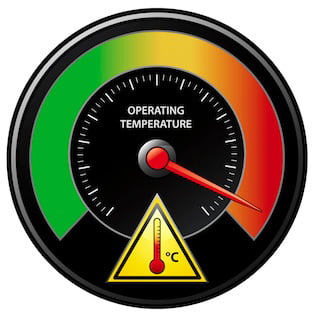When Is Enclosure Cooling Needed to Protect Electrical Equipment from Overheating?
Although modern electrical equipment is robust, widespread use of power components has increased the need for controlling the temperature of electrical enclosures. Specifications vary but electrical equipment manufacturers generally recommend that enclosure temperatures be kept below 95ºF (35ºC) to protect sensitive components.
It is possible to manage enclosure temperatures through the use of natural ventilation. However, there are at least three situations where enclosure cooling requires an active solution to protect equipment from overheating.
High Ambient Temperatures
At times, designers have no choice but to locate electrical enclosures in locations where the ambient temperatures are excessively high. Some examples include:
- Outdoors in the sun: The internal temperature of an electrical enclosure situated in the sun, especially in a hot, dry location, will readily exceed 95ºF due to the effects of solar radiation.
- Hot, poorly ventilated areas: If natural ventilation is poor, such as in an enclosed machine room or on board a ship, internal enclosure temperatures could easily exceed 95ºF.
- Close proximity to hot equipment: Sometimes it’s necessary to place electrical enclosures close to hot equipment, such as arc furnaces or kilns. The combined effects of radiation and convection may cause the enclosure temperature to rise unless cooling is provided.
High Internal Heat Load
If the heat load in an electrical enclosure is high, then it’s likely that enclosure cooling beyond a fan will be needed to keep the enclosure’s internal temperature below 95ºF. Some instances include:
- Electronic drives: The heat generated by an electronic drive is related to the drive’s efficiency and output power. Because the efficiency is typically 95 to 97 percent, 3 percent of the energy used is lost as waste heat.
- PLCs: A significant amount of heat is generated by PLC power supplies and other electronic modules.
- Heavily loaded panels: In some situations, space is limited, and enclosures have a high equipment density that can lead to overheating. This is especially true if the enclosure contains a lot of high-power equipment.
When Enclosures Must Be Sealed
There may be a need to seal electrical enclosures to protect the internal components from the environment. This eliminates natural ventilation as an option. Typical examples of said circumstances include:
- Dirt and dust: If the enclosure is in a very dusty environment, dirt can contaminate equipment surfaces and cause electrical malfunction.
- Water splashing: In some locations, equipment needs to be washed down for health and hygiene reasons. It’s possible for the cleaning process to lead to water splashes, resulting in a requirement to seal the enclosure.
- Outdoors: An outdoor enclosure is subject to windblown rain, dirt, and dust and may need to be sealed to prevent the ingress of moisture and dirt.
- Pollutants: If corrosive chemical vapors are present, the enclosure should be sealed to prevent corrosion of electrical equipment.
In such instances, overheating may occur unless enclosure cooling is used.
Enclosure Cooling Options
The method of enclosure cooling adopted depends on the total enclosure heat load plus any external heat load, like solar radiation. If there is no requirement for a sealed enclosure, it may be possible to use fan-assisted ventilation for temperature control. However, this approach is unlikely to be effective if the heat load is high. The optimum solution would be either an air-to-air heat exchanger or, for higher heat and arduous locations, a closed-loop air conditioner.
Each case should be evaluated on its merits. If you need guidance, please contact our support team at Thermal Edge; they will be able to propose the best method to manage your electrical enclosure temperature.



